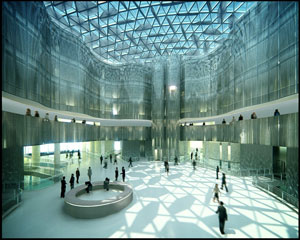by: Lisa Delgado
Events: Buckminster Fuller Symposium: On Architecture, Design and Science; On Influence and Contemporary Art
Location: The Cooper Union for the Advancement of Science and Art, 09.13.08
Speakers: On Architecture, Design and Science: Peter Galison — Joseph Pellegrino University Professor of the History of Science and of Physics, Harvard University; Chuck Hoberman — Founder & President, Hoberman Associates; Felicity Scott — Assistant Professor of Architecture, Columbia University Graduate School of Architecture, Planning and Preservation; Anthony Vidler — Dean & Professor, The Irwin S. Chanin School of Architecture of The Cooper Union; On Influence and Contemporary Art: Carol Bove — Artist; Elizabeth A. T. Smith — James W. Alsdorf Chief Curator and Deputy Director for Programs, Museum of Contemporary Art, Chicago; Victoria Vesna — Artist; Pedro Reyes — Artist
Moderators: On Architecture, Design and Science: K. Michael Hays — Eliot Noyes Professor of Architectural Theory, Harvard University Graduate School of Design & Adjunct Curator of Architecture, Whitney Museum of American Art; Margie Weinstein — Senior Coordinator of Public Programs and Academic Initiatives, Whitney Museum of American Art (introduction); On Influence and Contemporary Art: Dana Miller — Associate Curator, Whitney Museum of American Art; Margie Weinstein — Senior Coordinator of Public Programs and Academic Initiatives, Whitney Museum of American Art (introduction)
Organizer: The Cooper Union for the Advancement of Science and Art
A quarter century after his death, Buckminster Fuller’s theories and inventions are still sending ripples of influence through the work of contemporary designers, architects, and artists. Therefore, a recent symposium aimed not only to historicize Fuller, but to explore his work’s ongoing relevance.
Chuck Hoberman of Hoberman Associates, an artist, inventor, engineer, and designer who often collaborates with architects, has been profoundly influenced by Fuller. Like Fuller, he shares a love of highly geometric and eco-friendly designs, as evidenced in his “transformable design” — structures and objects that can change in size, shape, form, and surface. In an era of global warming, devices such as Hoberman’s sun-responsive shades represent a form of adaptation, he said, offering a quote from structural designer Peter Rice: “When we get into trouble, we invent our way out of it.” For Madrid’s planned Audiencia Provincial (Appeals Court) by Foster + Partners, Hoberman designed such a system made from hexagonal shading cells that sense light levels and close as needed, creating leaf-like, dappled shadows inside the atria that minimize unwanted solar gain while maximizing natural light.
Aside from Hoberman’s discussion of his architectural collaborations, there wasn’t much talk about Fuller’s influence on architecture in the session titled “On Architecture, Design and Science.” Anthony Vidler made a case for the value of Fuller’s architectural work, despite Fuller’s autodidact status, but the bulk of his talk was on Fuller’s relationship with artist-writer John McHale.
One session was entirely devoted to Fuller’s influence in the realm of contemporary art. Artist Pedro Reyes presented his “Velotaxi” (2007), a human-powered vehicle reflecting a concern with aesthetics coupled with sustainability, along with several mathematically based sculptures recalling the familiar Fuller domes. Reyes also once took inspiration from Fuller’s geographical projects such as the World Game and the Dymaxion Map; his “Ideas for Iraq” (2008) is a table whose surface displays a digital map of Iraq and neighboring countries to help viewers visualize a war happening far away.
New-media artist Victoria Vesna discussed Fuller’s belief that art and science are closely aligned — the more advanced science gets, the closer it is to art, and vice versa. Both she and Carol Bove discussed some of their own artworks that use “tensegrity” structures, whether virtual or material. (The Fuller-coined term “tensegrity” refers to structures with a synergy between tension and compression components.) Elizabeth A.T. Smith of the Museum of Contemporary Art, Chicago, traced Fuller’s legacy in the work of several other artists, including Josiah McElheny, Andrea Zittel, and Olafur Eliasson.
While talks on Fuller at the Center for Architecture in June centered on personal anecdotes about him, featuring many of Fuller’s former associates (See “Bucky: Longtime Hero to a Few, at Last Comes into his Own,” by Lisa Delgado, 07.08.08), these talks complemented that earlier event, bringing an examination of Fuller’s work up to date.
Lisa Delgado is a freelance journalist who has written for OCULUS, The Architect’s Newspaper, Blueprint, The LEAF Review, and Wired, among other publications.








